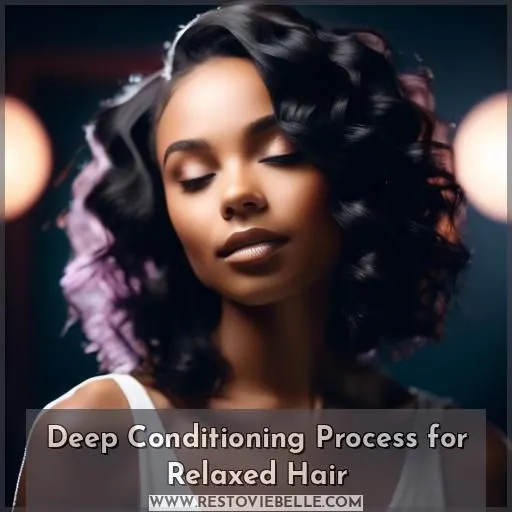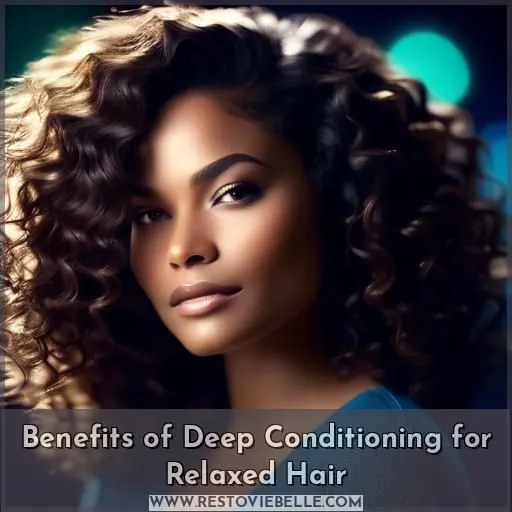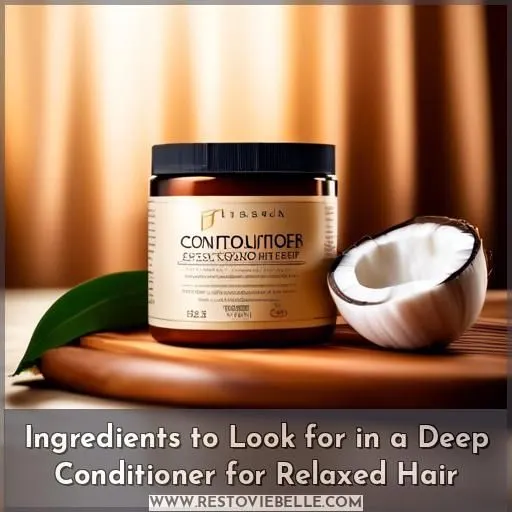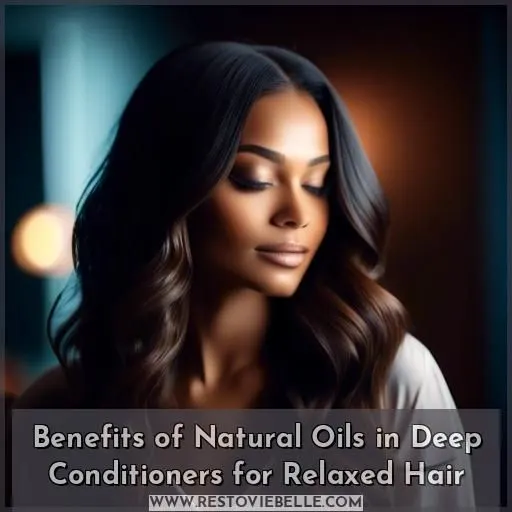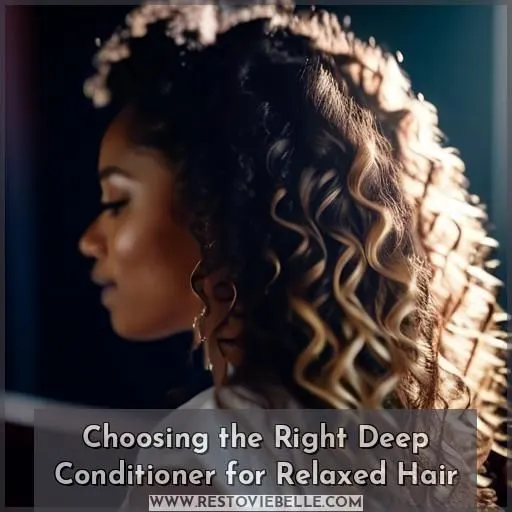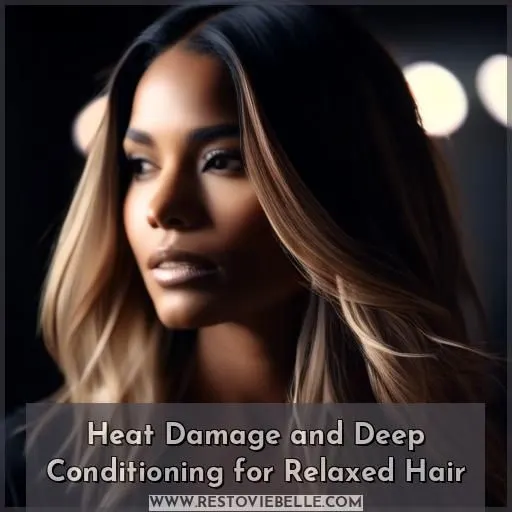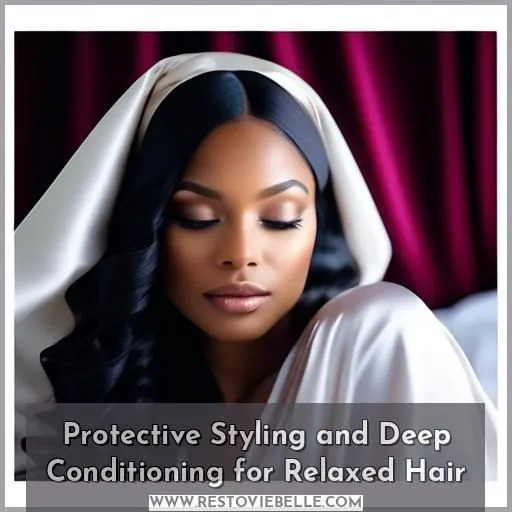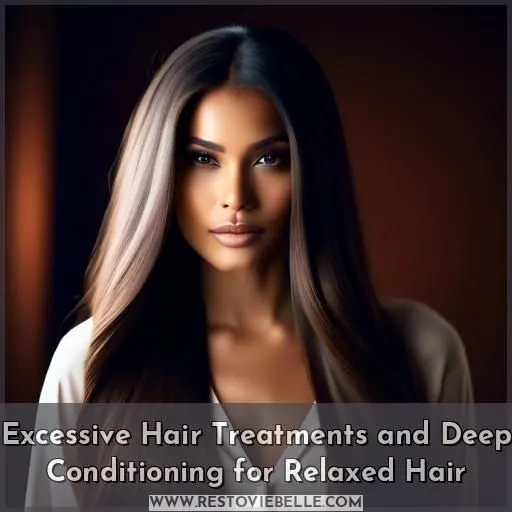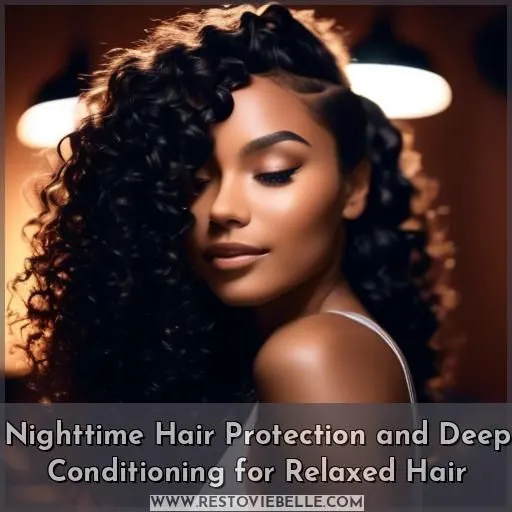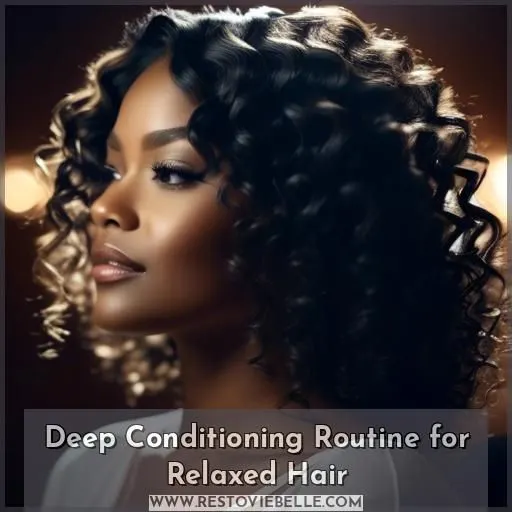This site is supported by our readers. We may earn a commission, at no cost to you, if you purchase through links.
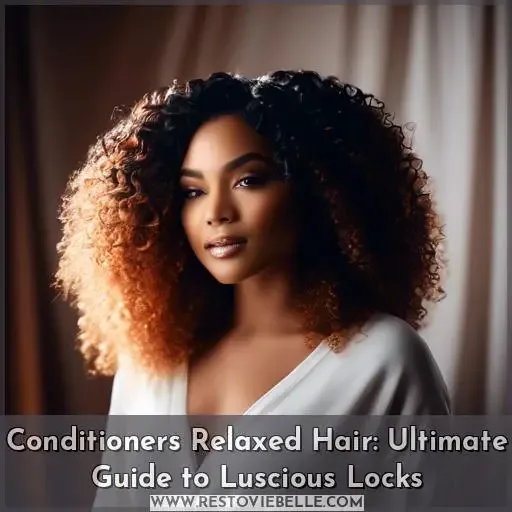
For radiant, supple locks, you’ll need to intensively condition regularly with tailored products.
Seek deep conditioners brimming with proteins to restore bonds, and natural oils such as argan or coconut for profound hydration.
Apply to freshly cleansed hair, leaving it on for 15-20 minutes, and utilize heat for enhanced absorption.
Intensive conditioning replenishes strands, minimizes breakage, heightens luster, and enhances tractability.
It’s also crucial to minimize heat styling and employ protective styles.
Eager to unleash your hair’s true potential? Continue reading for an in-depth guide to nurturing relaxed tresses.
Table Of Contents
- Key Takeaways
- Deep Conditioning Process for Relaxed Hair
- Benefits of Deep Conditioning for Relaxed Hair
- Ingredients to Look for in a Deep Conditioner for Relaxed Hair
- Benefits of Natural Oils in Deep Conditioners for Relaxed Hair
- Choosing the Right Deep Conditioner for Relaxed Hair
- Heat Damage and Deep Conditioning for Relaxed Hair
- Protective Styling and Deep Conditioning for Relaxed Hair
- Excessive Hair Treatments and Deep Conditioning for Relaxed Hair
- Nighttime Hair Protection and Deep Conditioning for Relaxed Hair
- Deep Conditioning Routine for Relaxed Hair
- Frequently Asked Questions (FAQs)
- What is the recommended frequency for deep conditioning relaxed hair?
- How long should I leave a deep conditioner on my relaxed hair?
- Can I use a heating cap or hooded dryer for deep conditioning?
- What are the best natural oils to add to a deep conditioner for relaxed hair?
- How does deep conditioning help with heat damage in relaxed hair?
- Conclusion
Key Takeaways
- Deep conditioning is crucial for relaxed hair, as it helps to hydrate, fortify, and protect the hair from damage.
- Regular deep conditioning can reduce split ends, dryness, and breakage, and improve elasticity and manageability.
- Natural oils like argan, black castor, and coconut oil can be added to deep conditioners to provide extra hydration and shine.
- To enhance penetration, deep conditioners can be left on for 15-20 minutes and heated using a heating cap or hooded dryer.
Deep Conditioning Process for Relaxed Hair
The deep conditioning process for relaxed hair begins with applying a rich, moisturizing deep conditioner or mask to freshly washed, damp hair. After saturating your strands, leave the treatment in for 15-20 minutes, and optionally use a heat cap or hooded dryer to enhance product penetration.
Apply a Deep Conditioner or Mask to Freshly Washed Hair
Apply a deep conditioner or mask to freshly washed hair to begin the deep conditioning process for relaxed hair.
The duration and frequency of deep conditioning will depend on your hair type and needs.
Leave-in conditioners can also be used for added moisture retention.
Scalp protection is essential, so avoid applying deep conditioners directly to the scalp.
When comparing products, look for deep conditioners that contain protein, moisture, and natural oils like argan, black castor, and coconut oil.
Deep conditioning can add oils to your hair for an extra boost of hydration and shine.
Leave in for 15-20 Minutes
After applying a deep conditioner or mask to your freshly washed relaxed hair, it’s time to let it work its wonders.
Leave it in for 15-20 minutes for maximum benefits.
This period allows the conditioner to thoroughly penetrate your hair, mending hair bonds and reducing breakage.
If you wish to enhance penetration, you can utilize a conditioning cap or warm the product before applying it.
Seek a deep conditioner with protein treatments, natural oils, and a dense consistency for optimal results.
Use Heat to Enhance Penetration (optional)
Deep conditioning is a vital part of hair care, particularly for relaxed hair. It aids in hydrating, fortifying, and safeguarding your hair from harm. One technique to increase the absorption of deep conditioners is by applying heat. Here’s how:
- Heating Cap or Hooded Dryer: Following the application of the deep conditioner, you can don a heating cap or sit beneath a hooded dryer for approximately 20 minutes. This warms the conditioner, permitting it to penetrate further into your hair shaft.
- Steam: An alternative method to enhance absorption is by steaming your hair. This fosters the lifting of the hair cuticle, allowing for greater permeation of the deep conditioner.
- Cool Down: Prior to rinsing, allow your hair to cool for a few minutes. This assists in sealing the cuticles, imparting a smoother and more lustrous appearance to your hair.
Benefits of Deep Conditioning for Relaxed Hair
You’ll be amazed by the transformative power of deep conditioning for relaxed hair. It’s a game-changer that revives dry, brittle strands by infusing much-needed moisture, strengthening hair bonds to prevent breakage, improving elasticity for easier styling, and restoring a gorgeous, healthy sheen that reflects light beautifully.
Reduces Split Ends, Dryness, and Breakage
Deep conditioning plays a vital role in preserving the health and beauty of relaxed hair. It aids in minimizing split ends, dryness, and breakage, ensuring your hair remains resilient and radiant. Here are four ways deep conditioning enhances your relaxed hair:
- Mitigates Split Ends: Deep conditioning with components such as coconut oil and proteins assists in sealing hair cuticles, decreasing the risk of split ends.
- Hydrates Hair: Deep conditioners saturate hair with moisture, preventing aridity and fragility.
- Fortifies Hair: By restoring hair bonds and enhancing elasticity, deep conditioning promotes hair growth and diminishes breakage.
- Enhances Radiance: Deep conditioning treatments can impart a lustrous and radiant appearance to your hair, giving it a healthy, glossy finish.
Remember to select a deep conditioner with a viscous texture and natural oils like argan, black castor, or coconut oil for maximum benefits. Additionally, consider employing a heat cap to improve penetration and optimize the advantages.
Hydrates Hair, Preventing Dryness
Hydration plays a pivotal role in preserving the well-being and radiance of relaxed hair. Deep conditioning treatments can be groundbreaking, as they replenish moisture and revitalize the natural luster of your hair. Here’s a guide to hydrating your relaxed hair with deep conditioning:
- Apply a Deep Conditioner: Opt for a deep conditioner or hair mask tailored specifically for relaxed hair, such as the Keracare Humecto Creme Conditioner. Apply it to freshly washed hair, ensuring that it saturates all strands evenly.
- Leave it On: Deep conditioners should remain on for at least 15-20 minutes, or even up to an hour for optimal results. You can employ a heat cap to facilitate penetration, but this step isn’t mandatory.
- Rinse Thoroughly: After the conditioning time, rinse your hair meticulously to eliminate all traces of the product. You can utilize this deep conditioning treatment weekly or as necessary, based on your hair’s condition and styling habits.
Deep conditioning can mitigate dryness, prevent breakage, and enhance elasticity, rendering your hair more manageable and resistant to styling damage. Ingredients like shea butter, coconut oil, olive oil, aloe vera, and honey in deep conditioners can provide additional hydration and nourishment to your relaxed hair.
Strengthens Hair, Reducing Breakage and Promoting Growth
Deep conditioning is the key to strengthening your relaxed hair, reducing breakage, and promoting growth.
By applying a deep conditioner or mask to freshly washed hair and leaving it in for 15-20 minutes, you can provide your hair with the nutrients it needs to thrive.
For even better results, use a heat cap to enhance penetration.
Deep conditioning offers numerous benefits, including reduced split ends, improved hydration, and increased elasticity.
This, in turn, makes your hair more manageable and less prone to damage from styling and environmental factors.
Improves Elasticity and Manageability
Deep conditioning your relaxed hair is pivotal for hydration and hair development.
Moreover, it markedly enhances elasticity and controllability.
This process fortifies your hair, rendering it more robust against breakage and fostering healthy hair growth.
By integrating deep conditioning into your hair care regimen, you’ll revel in hair that’s not solely stronger but also more adaptable.
Turning styling into a breeze.
Enhances Shine and Appearance
After enhancing your hair’s flexibility and control, let’s explore how deep conditioning illuminates your locks and bestows upon them a lustrous, magazine-worthy appearance. Envision catching a glimpse of yourself and being captivated by the radiant shine of your hair.
- Your tresses become the object of admiration, eliciting countless inquiries about your hair care routine.
- Acquaintances implore you to share your home remedies, alluding to your undisclosed formula.
- Organic ingredients nurture your hair, gently caressing each strand with whispers of nourishment.
- Overnight treatments transform into magical elixirs, ensuring you awaken to a miraculous transformation.
- Comprehending hair porosity empowers you with a newfound ability to achieve unparalleled luminosity.
Prevents Damage From Styling and Environmental Factors
Deep conditioning is an essential step in preserving the well-being and aesthetics of chemically treated hair. It aids in restoring hydration, safeguarding against breakage, and shielding hair from styling and environmental stressors. Deep conditioning treatments can be performed at home or in a salon, and usually entail applying a conditioner or mask to freshly cleansed hair, leaving it in for 15-20 minutes, and optionally using heat to facilitate penetration.
The advantages of deep conditioning for chemically treated hair are manifold. It assists in minimizing split ends, aridity, and breakage, hydrates the hair, and fortifies hair strands, fostering growth. Deep conditioning also enhances hair elasticity, rendering it more manageable and less susceptible to damage.
When selecting a deep conditioner for chemically treated hair, seek products that feature water as the primary ingredient, proteins to mend hair bonds, and natural oils such as argan oil, black castor oil, and coconut oil to impart moisture and luster.
To optimize the efficacy of deep conditioning, contemplate utilizing a heat cap or wrapping to augment penetration, and endeavor to deep condition weekly or as required to counteract heat damage and maintain the health of your chemically treated hair.
Ingredients to Look for in a Deep Conditioner for Relaxed Hair
When it comes to deep conditioning your relaxed hair, you want to choose a product with water as the first ingredient to provide ample hydration.
It’s also crucial to look for proteins like keratin to rebuild and strengthen the bonds within your strands.
A thick, creamy consistency will fully coat each strand.
Natural oils like argan, black castor, and coconut oil are excellent additions, as they deeply nourish and protect your relaxed tresses.
Water as the First Ingredient
Regarding deep conditioning treatments for relaxed hair, the primary element to consider is water. Aqueous conditioners are indispensable for infusing hair with moisture, which is paramount for preserving its vitality and minimizing breakage. These conditioners abound in components that draw in water, rendering them an ideal option for revitalizing and fortifying relaxed hair.
Here are three compelling reasons why water should be the foremost ingredient in your deep conditioner:
- Hydration: Water constitutes the cornerstone of any effective deep conditioner. It facilitates hair hydration, counteracting dryness and fragility.
- Effortless Application: Aqueous conditioners are facile to apply and rinse out, making them a practical choice for individuals with packed schedules.
- Adaptability: Aqueous conditioners are suitable for all hair types, encompassing relaxed hair, which is susceptible to dryness and breakage.
Proteins to Rebuild Hair Bonds
Proteins are essential for maintaining healthy hair and indispensable in the process of deep conditioning for relaxed hair.
Protein treatments help to strengthen and repair damaged strands. They infuse protein-rich ingredients that replenish the hair’s natural protein structure, improving elasticity and reducing breakage.
These treatments are particularly beneficial for relaxed hair, which is more susceptible to breakage due to the chemical process involved in straightening the hair.
By using high-quality protein treatments containing hydrolyzed proteins, you can fill in any gaps or weak spots in the hair shaft, fortifying the hair structure, reducing breakage, and promoting overall hair health.
Thick Consistency
Deep conditioning is the process of applying a thick, moisturizing hair conditioner or mask to freshly washed hair and leaving it on for 15 minutes to an hour. Using a heat cap can enhance the penetration of the deep conditioner.
The key benefits of deep conditioning for relaxed hair include:
- Reducing split ends, dryness, and breakage
- Hydrating the hair to prevent dryness
- Strengthening the hair to reduce breakage and promote growth
- Improving hair elasticity and manageability
- Making the hair shiny and glossy by enhancing hydration
- Preventing damage from everyday styling and environmental factors
When choosing a deep conditioner for relaxed hair, look for ingredients like water as the first ingredient, proteins to rebuild hair bonds, a thick consistency, and natural oils like argan, black castor, or coconut oil. The natural oils help add extra moisture and nourishment.
Regular deep conditioning is essential for maintaining healthy, hydrated relaxed hair and preventing issues like heat damage, lack of protective styling, excessive hair treatments, and lack of nighttime hair protection.
Natural Oils (argan Oil, Black Castor Oil, Coconut Oil)
Regarding deep conditioning for relaxed hair, natural oils such as argan oil, black castor oil, and coconut oil are your allies.
These oils infuse moisture and nourishment, fortifying hair and minimizing breakage.
Argan oil’s attributes include hydration and radiance.
Black castor oil imparts strength and flexibility.
Coconut oil infuses moisture and safeguards hair from damage.
Integrate these natural oil enhancements into your deep conditioner for a profoundly nourishing treatment.
Benefits of Natural Oils in Deep Conditioners for Relaxed Hair
The nourishing benefits of natural oils make them a coveted ingredient in deep conditioners for relaxed hair. Their emollient properties penetrate strands, delivering intense moisture while strengthening hair to minimize breakage and enhance radiant shine.
Adds Oils for Deep Conditioning
Drench your locks in nature’s elixir with oils that turn deep conditioning into a spa retreat for your hair. Imagine the benefits as each application infuses strength into every strand. With the right ingredients, frequency, and products, you’re not just pampering your tresses; you’re arming them with resilience against the daily tug-of-war with combs and brushes.
Moisturizes and Nourishes Hair
Moisture retention and protein replenishment are key benefits of natural oils in deep conditioners for relaxed hair. These oils nourish and strengthen strands, reducing breakage and promoting elasticity. Incorporating natural oils into your deep conditioning routine can help protect your hair from damage caused by styling and environmental factors. Here are three ways natural oils can enhance your deep conditioning experience:
- Moisture Retention: Argan oil, black castor oil, and coconut oil help lock in moisture, preventing dryness and breakage.
- Protein Replenishment: Proteins in deep conditioners rebuild hair bonds, making hair stronger and more resilient.
- Protective Styling Impact: Protective styles like braids and twists keep ends tucked in, reducing damage from styling and environmental factors.
Strengthens Hair and Reduces Breakage
Deep conditioning is a crucial step in maintaining the health and appearance of relaxed hair.
By incorporating natural oils into your deep conditioner, you can strengthen your hair, reduce breakage, and improve its elasticity.
These oils help retain moisture, prevent damage, and enhance shine.
Regular deep conditioning treatments can make your hair more manageable and resilient, allowing it to withstand everyday styling and environmental factors.
So, don’t neglect this essential step in your hair care routine.
Enhances Shine and Luster
Just as a knight’s armor protects him in battle, deep conditioning with natural oils is your hair’s shining shield.
It’s not just about strength; it’s about that glossy sheen that turns heads.
Imagine your locks, lustrous as a moonlit path, thanks to the magic of hair masks and oils.
Suitable for All Hair Types
Deep conditioners with natural oils are a game-changer for relaxed hair.
They add oils for deep conditioning, moisturize and nourish, strengthen hair, and reduce breakage.
Look for ingredients like argan oil, black castor oil, and coconut oil.
These oils help rebuild hair bonds, promote hair growth, and restore hair health.
They’re suitable for all hair types, making them a versatile choice for anyone seeking hair repair and rejuvenation.
Choosing the Right Deep Conditioner for Relaxed Hair
When choosing a deep conditioner for your relaxed hair, it’s crucial to select products specifically designed for chemically treated strands.
Look for deep conditioning formulas that contain moisture-rich ingredients like natural oils.
Look for deep conditioning formulas that contain protein to fortify and rebuild the hair’s structure.
To further enhance manageability and add radiant shine, follow up your deep conditioning treatment with a leave-in conditioner or hair serum.
Consider Specific Products Designed for Relaxed Hair
Regarding deep conditioning for chemically straightened hair, it’s crucial to select products meticulously formulated for this hair type.
Seek out deep conditioners that address the distinct requirements of relaxed hair, like Keracare Humecto Creme Conditioner.
This product profoundly moisturizes and replenishes chemically straightened hair, fortifying it and minimizing breakage.
Additionally, it enhances hair’s flexibility and ease of styling, revitalizing its radiance and shine.
Look for Deep Conditioners That Contain Protein and Moisture
To maintain the optimal health of your relaxed hair, it’s imperative to select a deep conditioner that encompasses both protein and hydration.
Protein aids in the reconstruction of hair bonds.
Hydration replenishes and revitalizes your strands.
Envision it as an indispensable duo for your hair care regimen.
You wouldn’t want to forgo the salon-caliber treatment in the comfort of your own home.
Deep conditioning with a formula that’s abundant in protein and moisture will render your hair soft, pliable, and primed for any style.
Follow Up With a Leave-in Treatment for Added Sheen
- Choose a Leave-in Serum or Treatment:
- Look for a leave-in serum or treatment that suits your hair type and goals.
- Consider serums that offer intense moisturization, protection against humidity, or seal in hydration.
- Apply to Damp Hair:
- Apply the leave-in serum or treatment to damp hair, focusing on the ends and midshafts.
- Be sure to avoid applying the serum to your roots to prevent weighing down your hair.
- Comb Through for Even Distribution:
- Use a wide-tooth comb or your fingers to distribute the serum evenly through your hair.
- This will help guarantee that the serum reaches all areas of your hair, smoothing out any knots or tangles.
- Allow to Dry Naturally:
- Let your hair air-dry naturally, without using a hairdryer, to allow the serum to fully absorb into your hair.
- This will help prevent product buildup and guarantee that your hair looks and feels healthy.
- Reapply as Needed:
- If you find that your hair needs an extra boost of shine or moisture, you can reapply the leave-in serum or treatment as needed.
- However, be sure to use the serum sparingly to avoid overloading your hair.
Heat Damage and Deep Conditioning for Relaxed Hair
You should avoid excessive heat styling tools like blow dryers and flat irons, as they can sap moisture from your relaxed hair, leading to dryness and damage. Instead, use a heat protectant spray and let your hair air-dry whenever possible; deep conditioning weekly or as needed will help combat heat damage by replenishing moisture and strengthening your strands.
Avoid Excessive Heat Styling Tools
Avoid excessive heat styling tools to prevent heat damage, which can lead to dry, damaged hair and excess breakage. Instead of blow-drying, consider air-drying your hair or using a heat protectant spray. Deep conditioning weekly can also help combat heat damage and restore shine and manageability to your relaxed hair.
Use Heat Protectant Spray or Air-dry Hair Instead of Blow-drying
Don’t let heat damage ruin your relaxed hair!
Instead of blow-drying, opt for air-drying or use a heat protectant spray.
Deep conditioning weekly or as needed can also help combat heat damage.
Keep your hair healthy and luscious by taking care of it in and out of the salon.
Deep Condition Weekly or as Needed to Combat Heat Damage
Deep conditioning is an essential step in maintaining the well-being of relaxed hair. To counteract heat damage, you should deep condition your hair weekly or as necessary. Here are three ways to deep condition your hair:
- Apply a thick hair conditioner or mask to freshly washed hair.
- Leave it in for 15 minutes to an hour.
- Use a heat cap to enhance penetration.
Deep conditioning helps reduce split ends, dryness, and breakage, hydrates hair, and strengthens hair against combing and brushing. Look for deep conditioners with proteins, natural oils, and a thick consistency. Protective styling and using natural oils can also enhance the benefits of deep conditioning.
Protective Styling and Deep Conditioning for Relaxed Hair
Protective styles like buns, updos, twists, braids, and wigs are a game-changer for relaxed hair. They keep your ends tucked away, preventing dryness and breakage. Mix up your regular look by rocking these low-maintenance, hydrating styles – your hair will thank you.
Protective Styles Keep Ends Tucked in and Prevent Hair From Drying Out
Protective styles are an indispensable ally for your hair’s well-being in terms of preventing breakage.
These hairstyles, such as buns, updos, twists, braids, and wigs, safeguard your hair’s ends and shield it from dryness.
By embracing protective styles, you not only safeguard your hair from damage but also empower it to become more robust.
Adopt these styles and witness the remarkable transformation of your hair!
Examples Include Buns, Updos, Twists, Braids, Wigs
Protective styling is a creative way to express yourself while keeping your relaxed hair healthy.
Buns, updos, twists, braids, and wigs are just a few examples.
These styles keep your ends tucked in and prevent your hair from drying out.
Experiment with different looks to change up your regular style.
Change Up Regular Look With Protective Styles
Protective styles are your hair’s closest companion in regard to sustaining gorgeous locks. Through securing the ends and guarding against dryness, these styles facilitate moisture preservation, fracture prevention, and even hair expansion. From buns and updos to twists, braids, and wigs, the choices are limitless. Therefore, don’t hesitate to transform your usual appearance with these chic and shielding alternatives.
Excessive Hair Treatments and Deep Conditioning for Relaxed Hair
The relaxer process breaks down the disulfide bonds in your hair, leaving strands weak and vulnerable.
Regular permanent color treatments and bleaching can wreak further havoc on relaxed tresses. It’s best to avoid them or at least minimize their use.
Instead, opt for gentler semi-permanent dyes if you crave a color change. Always consult a professional stylist well-versed in caring for relaxed hair before undergoing any chemical process.
Relaxer Process Breaks Down Disulfide Bonds in Hair
To comprehend the impact of relaxer treatments on hair, it’s imperative to recognize that relaxers function by severing disulfide bonds in the hair, which are significantly more robust than hydrogen bonds. These disulfide bonds are responsible for maintaining the cohesion of the hair’s proteins, and their disruption alters the hair’s inherent texture, resulting in a straightened appearance. However, this process can lead to hair damage, including breakage, thinning, and even hair loss due to the aggressive chemicals employed in relaxers.
Relaxers, especially those containing potent alkaline agents like sodium hydroxide, can cause scalp irritation, burns, and even chemical burns if left on for an extended period. These issues can be heightened by the use of alcoholic hair products, which can cause long-term scalp damage or bald spots. Furthermore, repeated use of relaxers can result in hair loss, scalp burns, and other severe health concerns, which can have profound impacts on an individual’s well-being and self-esteem.
To mitigate the potential damage from relaxers, it’s paramount to adhere to these guidelines:
- Select the appropriate relaxer: Opt for products that are specifically tailored to your hair type and consider using no-lye relaxers, which contain milder alkaline agents that are less likely to cause burns.
- Professional application: Have your relaxer applied by a trained professional to minimize the risk of damage and injury.
- Follow instructions: Always use relaxers according to the manufacturer’s instructions, including recommended application time and precautions.
- Protect your scalp: Apply a protective layer, such as petroleum jelly, to your scalp before applying the relaxer to lessen irritation and burns.
- Limit frequency: Avoid relaxing your hair excessively, as this can lead to increased damage and potential hair loss.
Permanent Coloring And/or Bleaching Can Damage Relaxed Hair
Permanent coloring and/or bleaching can damage relaxed hair.
These treatments contain ammonia, which can alter hair porosity and increase hair fragility.
Over time, excessive use of these treatments can lead to hair protein loss, resulting in weak, brittle strands.
Opt for temporary dyes or ammonia-free dyes that are gentler on hair, or consult with a hairstylist for advice on coloring your relaxed hair without causing damage.
Try Semi-permanent Dyes That Are Gentler on Strands
Regarding the coloring of your relaxed hair, semi-permanent dyes offer a less abrasive alternative to permanent hair color. These dyes lack ammonia, a common component in permanent hair color that can harm the hair cuticle and strands. Instead, semi-permanent dyes adhere to the hair shaft without penetrating it, providing color that persists for roughly 6-12 shampoos.
Semi-permanent dyes are an excellent choice for individuals seeking to experiment with color without committing to a permanent alteration. They can also enhance and complement your natural hair color, concealing gray hairs without causing significant damage. When utilizing semi-permanent dyes, it’s imperative to conduct a skin allergy test 48 hours prior to application and meticulously adhere to the instructions to prevent potential irritation.
To achieve optimal results and minimize hair damage, consider seeking guidance from a hairstylist before coloring your relaxed hair. A professional can assist you in selecting the appropriate dye and provide guidance on the application process, guaranteeing that your hair remains healthy and radiant.
Consult With a Hairstylist Before Coloring Relaxed Hair
When it pertains to coloring your chemically straightened hair, it’s essential to consult with a hairstylist before making any significant alterations.
Hair dyes and coloring treatments can be abrasive on relaxed hair, potentially resulting in damage or breakage.
A hairstylist can evaluate your hair’s well-being and recommend the optimal hair coloring or dye for your particular requirements.
They can also offer guidance on how to maintain your hair’s health throughout and after the coloring process.
Avoid Bleaching Relaxed Hair
Bleaching relaxed hair can be damaging if not done properly.
It’s recommended to wait at least two weeks after a relaxer treatment before bleaching to give the hair time to normalize and restore moisture.
Additionally, it’s essential to use a mild or medium-strength relaxer and never take the hair to bone straight if you’re planning to lighten or bleach it.
If you must bleach relaxed hair, be prepared for quick processing and monitor the bleaching process carefully.
It’s also imperative to deep condition your hair regularly to prevent breakage and promote growth.
Nighttime Hair Protection and Deep Conditioning for Relaxed Hair
Protecting your relaxed hair at night is crucial to prevent friction, breakage, and moisture loss. Wrap your hair in a silk or satin scarf or pillowcase before bed to avoid the moisture-sapping effects of cotton and keep lint from clinging to your strands.
Wrap Hair Before Bed to Protect From Friction and Breakage
Wrapping your hair before bed is a simple yet effective way to protect it from friction and breakage.
This nighttime ritual can substantially lessen the risk of damage, particularly for those with relaxed hair.
By using a silk or satin scarf or pillowcase, you can prevent moisture depletion and foster overall hair well-being.
Adopt this straightforward habit for healthier, more radiant hair.
Use a Silk or Satin Scarf or Pillowcase to Prevent Moisture Loss
Using a silk or satin pillowcase can prevent moisture loss and protect your hair from damage during your nighttime routine. Silk is a protein-based fabric that naturally moisturizes your hair and skin, keeping them hydrated and healthy. Here are three reasons why you should consider using a silk or satin pillowcase:
- Moisture Retention: Silk helps your hair and scalp retain moisture, preventing drying out and breakage.
- Friction-Free: The smooth surface of a silk pillowcase reduces friction, preventing tangles and breakage.
- Hypoallergenic: Silk is naturally hypoallergenic, resistant to mold, fungus, and dust mites, making it a gentle environment for your hair and skin.
Keep Lint From Sticking to Hair
Preventing lint adherence is vital for overnight hair protection and deep conditioning of relaxed hair.
Lint can induce friction and breakage, contributing to hair loss and damage.
To mitigate this, utilize a silk or satin scarf or pillowcase, which minimizes lint buildup and lowers the risk of breakage.
Maintain your hair care regimen with deep conditioning treatments to preserve hair integrity and reduce breakage.
Prevents Loss of Moisture and Damage From Styling
Preserving the integrity of your chemically straightened hair is essential for maintaining its vitality and luster.
To achieve this:
Incorporate natural oils into deep conditioners for enhanced hydration and resilience.
Utilize heat protectant sprays to safeguard against styling tools.
Choose protective hairstyles that conceal the ends and shield them from dehydration.
Shield your hair before bed with silk or satin fabrics.
Steer clear of excessive treatments that may compromise its health.
By adhering to these recommendations, you will cultivate healthy, radiant hair that is primed for any style or event.
Deep Conditioning Routine for Relaxed Hair
Deep conditioning is a vital step in maintaining healthy, lustrous relaxed hair. The process involves applying a rich conditioner or mask to freshly washed hair, leaving it in for 15-20 minutes, and using heat to enhance penetration if desired. Deep conditioning offers numerous benefits, including reducing split ends, dryness, and breakage, hydrating hair, and promoting elasticity. It also prevents damage from styling and environmental factors, making hair shiny and lovely.
When choosing a deep conditioner for relaxed hair, look for products with water as the first ingredient, proteins to rebuild hair bonds, a thick consistency, and natural oils like argan oil, black castor oil, or coconut oil. These ingredients add moisture, nourish hair, and strengthen it, reducing breakage and enhancing shine.
To create a deep conditioning routine, consider the following tips:
- Product Selection: Choose a deep conditioner specifically designed for relaxed hair, like the Keracare Humecto Creme Conditioner.
- Frequency: Deep condition weekly or as needed to combat heat damage and maintain hair health.
- Heat Damage Prevention: Use heat protectant spray or air-dry hair instead of blow-drying to prevent heat damage.
- Protective Styling: Incorporate protective styles like buns, updos, twists, braids, or wigs to keep ends tucked in and prevent hair from drying out.
Frequently Asked Questions (FAQs)
What is the recommended frequency for deep conditioning relaxed hair?
You should deep condition your relaxed hair weekly, love. That intense hydration replenishes moisture, adds shine, and prevents those pesky split ends from cramping your style. Think of it as a rejuvenating spa day for your thirsty tresses!
How long should I leave a deep conditioner on my relaxed hair?
You’ll want to leave that deep conditioner on for 15-30 minutes, boo. Give those strands a chance to really drink it in and get hydrated! But don’t leave it too long—an hour max to avoid overconditioning.
Can I use a heating cap or hooded dryer for deep conditioning?
Over 90% of women see better results when using heat for deep conditioning. Yes, use a heating cap or hooded dryer – it helps conditioner penetrate strands, preventing dryness and breakage. Your hair will thank you for that extra pampering!
What are the best natural oils to add to a deep conditioner for relaxed hair?
You can’t go wrong with moisturizing oils like coconut, olive, or avocado. They’ll deeply penetrate and nourish your relaxed strands, adding unbeatable softness and manageability. Treat your hair to that luxurious TLC it deserves!
How does deep conditioning help with heat damage in relaxed hair?
Like a knight’s armor against fiery dragons, deep conditioning shields your luscious locks from heat’s brutal assaults. This fortifying elixir replenishes lost moisture, preventing that dreaded crispy, brittle look. Your tresses will emerge radiant and resilient, fearless in battle against scorching styling tools.
Conclusion
Did you know that relaxed hair is prone to dryness and breakage? You’ll need deep conditioners packed with proteins and natural oils like argan or coconut. Regular deep conditioning replenishes moisture, minimizes split ends, enhances shine, and improves manageability for your relaxed tresses. Adopt this routine, avoid excessive heat styling, and embrace protective styles for radiant, luscious locks.
